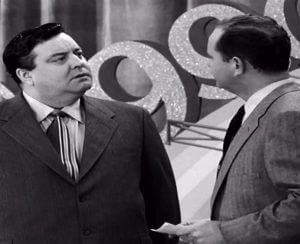 Today is Chaos Never Dies Day. At least, I think it is. When I first wrote about this unofficial holiday a decade ago, I had no idea I’d get tangled up in that chaos thanks to the Internet and a Florida man’s radio talk show. (More on that later.)
Today is Chaos Never Dies Day. At least, I think it is. When I first wrote about this unofficial holiday a decade ago, I had no idea I’d get tangled up in that chaos thanks to the Internet and a Florida man’s radio talk show. (More on that later.)
Why this holiday? Since no one has claimed responsibility for creating it, there’s no one to ask. Although a current AI search traces the first mention to 2016, the Internet Archive’s Wayback Machine still has a snapshot of my post about it from November 2015, and I can tell you I didn’t make it up—unless I traveled through time to give myself the idea.
I’m reminded of debates over whether Kyle Reese could hop in a time machine and sleep with Sarah Connor, thereby fathering the person who would one day send him back. What? That paradox in The Terminator still gives me a headache, so I’m just going to have to let Skynet win this one. Please don’t judge me.
Why today? November 9th might have been chosen because it coincides with the Northeast blackout of 1965. Or the day in 1888 when the last-known victim of Jack the Ripper was found. In the absence of evidence to the contrary, why not both?
What is chaos? I’m reminded of Supreme Court Justice Potter Stewart’s response when asked to describe obscenity. He couldn’t define it, he said, “but I know it when I see it.” Chaos can be equally hard to explain, at least for me, depending on myriad factors such as timing, location, and circumstances.
In Greek mythology, Chaos was the first primeval god to come into existence at the creation of the universe. Her name comes from the Latin khaos, meaning “gap” or the space between heaven and earth.
Chaos theory is a branch of mathematics that describes the behavior of non-linear systems and attempts to find underlying order in what appear to be random events or data.
Here are a few quotes illustrating different views of chaos.
We live in a rainbow of chaos. – Paul Cezanne
Freedom is just chaos, with better lighting. – Alan Dean Foster
Chaos is the score upon which reality is written. – Henry Miller
I like order. It allows me to have chaos in my head. – Dwight Yoakum
Here’s the dictionary definition.
Chaos
noun
1. A state of utter confusion or disorder; a total lack of organization or order.
2. Any confused, disorderly mass: a chaos of meaningless phrases.
3. The infinity of space or formless matter supposed to have preceded the existence of the ordered universe.
4. The personification of this in any of several ancient Greek myths.
5. Obsolete. A chasm or abyss.
And here comes my role in the story.
Chaos, 2017
On November 8, 2017, I was invited to speak about Chaos Never Dies Day on a radio show. With less than 24 hours’ notice, I scrambled to cram the online equivalent of Chaos Theory for Dummies to prepare.
The show’s booker told me I’d also be asked to explain how I came to write about weird holidays and talk about any notable ones taking place before the end of the year. I gathered information on two of the wackiest: Start Your Own Country Day and Tió de Nadal, which involves a Christmas log that craps out presents when beaten with a stick.
He didn’t tell me the show’s theme was “Are we Stuck in a Bad News Hell?” or that the guests before me would be talking about parenting in the wake of a mass shooting in Texas.

When Michael S. Robinson introduced me, I described the beauty of the order hidden within what we perceive as chaos, using the example of football, which can’t be predicted in strictly linear terms by the sum of the players’ and team’s rankings, because of variables like team chemistry, whether it’s a home or away game, the quarterback’s attitude, etc. Since I’m confident you’ll never hear the interview, I’m going to say it was brilliant.
But Mr. Robinson wanted to talk about everyday chaos. How did I try so hard yet end up woefully unprepared? I didn’t just strike out. I left my bat in the dugout and brought a cello to the plate. I’d like to credit chaos in some artful way by suggesting it created a perfect trajectory I can’t identify. That’s hogwash, of course—or is it? (It is.)
In my defense, I’d never heard the radio show before, and in my rush to speak knowledgeably about the theory behind the holiday and bring the funny about two other wacky holidays, I didn’t take the time to check it out. I was never asked about any of that.
And during the call, I had feedback blasting my words back at me, making it almost impossible to speak normally. There’s nothing worse than hearing your own voice faltering in near-real time. Again, chaos. It’s probably just as well they spelled my name Kathlene Zaya.
 All this reminds me of the $99,000 Answer, an episode of The Honeymooners in which Ralph Kramden prepares to go on a game show where he’ll be required to identify songs by the first few bars.
All this reminds me of the $99,000 Answer, an episode of The Honeymooners in which Ralph Kramden prepares to go on a game show where he’ll be required to identify songs by the first few bars.
He rents a piano and has Ed Norton play musical selections all week to prepare for the event. Ed always warms up by playing the first few bars of “Swanee River,” which never fails to annoy Ralph.
The night of the show, the first tune played is “Swanee River,” which he can’t name. He loses despite all his preparation. I laughed but felt bad for Ralph, perpetual loser.
It also reminds me of the Curb Your Enthusiasm episode where Larry David did something stupid or thoughtless because he misunderstood the context of a situation, or maybe because he was a jerk. (In other words, every episode.)
Fictional chaos theorist Ian Malcolm said in Jurassic Park, “Life finds a way.” So do laughs, but not always the ones you want or on the schedule you’d prefer.
Chaos, Now
Unsurprisingly, I’ve never been asked to return to Mr. Robinson’s show. Perhaps my invitation got lost in the (e)mail. There’s certainly much to discuss: Trump’s hair—pure chaos!—or the discovery that the Mayans invented television. (In honor of today’s holiday and to wash away the image of Trump, please click on that last link for the whacked-out philosophical stylings of a character in one of my favorite movies, Repo Man. Better yet, watch it.)
Also, in the first update I wrote in 2017, I misidentified fictional character Ian Malcolm as David Malcom. I regret the error and know that my use of flawed web research has introduced yet another tiny bit of chaos to the Internet. Whether I created this holiday or not, I guess you could say I’m doing my part.
Whether you choose to fight chaos today or welcome it with open arms, have a wonderful Chaos Never Dies Day! See you next year.
 November 11, 1929, was named Air Day by Governor Lawrence Judd to commemorate the first commercial air service flights between the Hawaiian Islands. Two Sikorsky S-38 planes flew from John Rodgers Airport, later renamed Honolulu International Airport, to the Big Island with a stop on Maui. Forty-nine military planes escorted them as far as Diamond Head; six accompanied them all the way to Hilo.
November 11, 1929, was named Air Day by Governor Lawrence Judd to commemorate the first commercial air service flights between the Hawaiian Islands. Two Sikorsky S-38 planes flew from John Rodgers Airport, later renamed Honolulu International Airport, to the Big Island with a stop on Maui. Forty-nine military planes escorted them as far as Diamond Head; six accompanied them all the way to Hilo. 



 All this reminds me of the
All this reminds me of the 